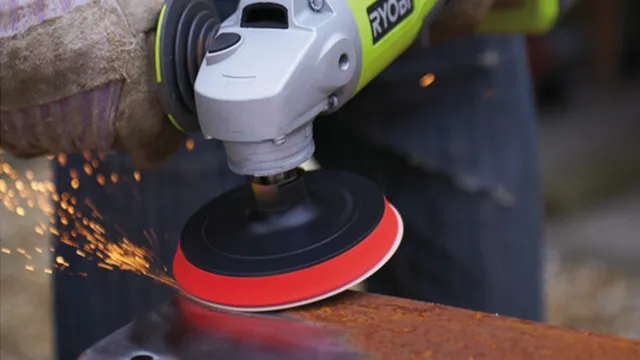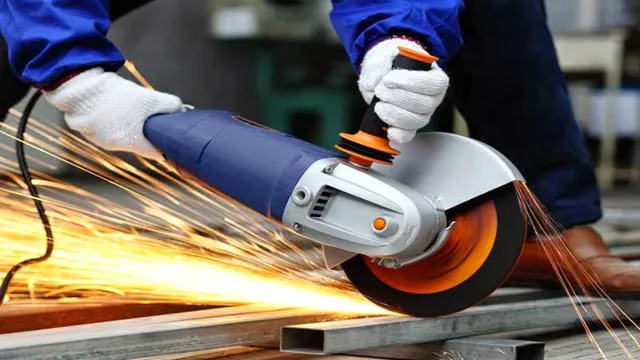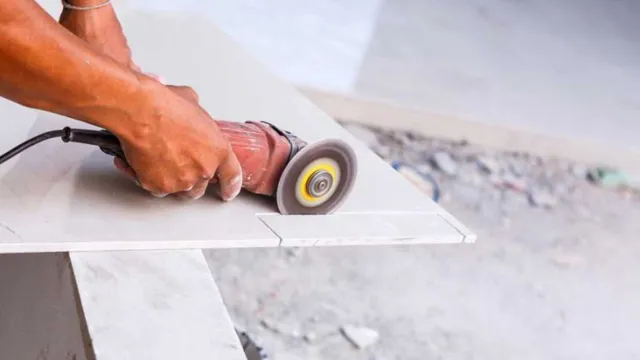What Can an Angle Grinder be Used for? Top 10 Versatile Uses for Your Workshop

If you’re into DIY projects or professional construction, an angle grinder is a must-have power tool. It’s a versatile handheld cutting tool that can perform various tasks, from removing rust and excess materials to cutting tiles and concrete. In this blog post, we’ll cover some of the most common uses of an angle grinder.
Whether you’re a beginner or just looking to expand your knowledge, read on to learn how this tool can take your projects to the next level.
Cutting Metal
An angle grinder is a versatile tool that can be used for a wide range of tasks, especially when it comes to cutting metal. The angle grinder’s powerful and fast rotating disc allows it to cut through metal like a hot knife through butter. It’s perfect for making precise cuts in metal pipes, removing old rusty bolts, or cutting through thicker sheets of metal.
An angle grinder can also be used to smooth rough edges, remove surface rust or paint, and shape metal. These are just a few of the many uses for an angle grinder when it comes to metalworking, making it an essential tool for anyone who works with metal regularly. So, if you’re looking for a versatile tool that can help you cut metal and complete a wide range of projects quickly and efficiently, an angle grinder is a tool you should definitely consider.
Cutting Tiles
Cutting metal tiles can be tricky, but there are a few techniques that can help you get the job done. One of the most common ways to cut metal tiles is to use a tile cutter specifically designed for metal. These cutters have a small diamond blade that can slice through even the toughest metal tiles with ease.
However, if you don’t have a tile cutter, you can also use a metal cutting saw or a jigsaw with a metal blade. Just be sure to wear proper protective gear and work slowly and steadily to avoid damaging the tile or injuring yourself. Additionally, it’s important to choose the right blade for the job based on the thickness and type of metal you are cutting.
By using the proper tools and techniques, you can achieve clean and precise cuts in your metal tiles for a polished finished result. So next time you’re tackling a DIY tile project, don’t let metal tiles intimidate you – with a little know-how, you can master the art of cutting them like a pro.

Cutting Masonry
When it comes to cutting metal in masonry work, there are several tools that can do the job effectively. The most common tool used is a metal cutting saw, which comes in both handheld and table saw versions. Handheld metal cutting saws are more versatile, as they can be used in tight spaces and for precision cuts, while table saws are better suited for larger and heavier materials.
Another popular option is the angle grinder, which uses a disc to precisely cut through metal. However, it is important to wear proper safety equipment when using these tools, such as eye protection and gloves, as the sparks and metal shavings can be hazardous. Regardless of which tool you choose, make sure to take your time and make smooth, steady cuts to avoid damaging the surrounding masonry.
Overall, with the right tools and precautions, cutting metal in masonry work can be done safely and effectively.
Grinding and Sanding
An angle grinder is a versatile tool that can be used for a variety of tasks, including grinding and sanding. With the right attachments, an angle grinder can be used to remove excess material, smooth rough edges, and create intricate shapes. This tool is commonly used for metalworking, woodworking, and masonry work, as well as for cutting and polishing materials.
When using an angle grinder, it is important to remember safety precautions such as wearing protective gear and using proper techniques to avoid injury. Overall, an angle grinder can be a valuable addition to any DIY toolkit, allowing you to tackle a wide variety of projects with ease. So, whether you’re a professional craftsman or a weekend hobbyist, an angle grinder can help you get the job done efficiently and effectively.
Sharpening Blades and Tools
When it comes to sharpening blades and tools, grinding and sanding are two common techniques. Grinding is the process of removing material from a blade or tool using a grinding wheel or belt. This method is ideal for fixing damaged or dull edges and restoring them to their original sharpness.
Sanding, on the other hand, involves using sandpaper or a sanding belt to buff away small nicks and burrs on blades and tools. This technique is ideal for honing edges to a smooth finish and for maintaining sharpness. While both of these techniques are effective, it’s important to choose the right method for the job at hand.
Using the wrong method can not only damage your tools, but it can also compromise the quality of your work. So, take the time to learn the differences between grinding and sanding, and choose the method that’s best suited for the task at hand. Remember, a sharp blade or tool is key to achieving high-quality results, so investing in excellent sharpening equipment is worthwhile.
Removing Rust and Paint
Grinding and sanding are two commonly used methods of removing rust and paint from various surfaces. Grinding involves using a motorized tool with a spinning abrasive disc to wear away the rust and paint. This method is ideal for larger areas, as it removes the material quickly and efficiently.
However, it can also result in deep scratches or gouges if not used properly. Sanding, on the other hand, involves using a sandpaper or sanding block to manually remove the rust and paint. This method is better suited for smaller areas or delicate surfaces, as it allows for more precise control and less risk of damage.
Whichever method you choose, it’s important to wear protective gear and work in a well-ventilated area to avoid inhaling any dust or particles released during the process. By removing rust and paint, you can restore the appearance and extend the lifespan of your metal objects or surfaces.
Polishing Metal
Polishing metal can be a challenging task to achieve. Grinding and sanding are two of the most popular methods to get the desired results. Grinding is a process that uses abrasive wheels to create a smooth and polished surface on the metal.
It’s ideal for removing large chunks of metal and deep scratches. Sanding, on the other hand, involves the use of sandpaper to create a smooth finish on the metal. It’s great for getting into tight spots and removing smaller scratches.
Both methods require proper safety measures, such as using protective gear and avoiding loose clothes and hair. Choosing the correct tools and techniques can help prevent damage to the metal and achieve the desired results. When polishing metal, it’s essential to start with the roughest grit of sandpaper or grinding wheel and work your way up to finer grits.
It’s also essential to take your time and not rush the process, as this can lead to mistakes and wasted effort. With practice and patience, achieving a polished metal surface can be accomplished.
Other Uses
Angle grinders are versatile tools that can be used for a variety of tasks beyond just cutting and grinding. One common use is for removing rust or paint from metal surfaces using a wire brush attachment. Angle grinders can also be used to sharpen different types of tools, including axes, hatchets, knives, and mower blades.
Another use is for polishing and sanding surfaces, such as car paint or concrete floors, using specific attachments. Additionally, angle grinders can be used to carve or shape wood or stone, making them a great tool for DIY projects or professional woodworking. With the right attachments and techniques, an angle grinder can be a handy tool for many different jobs.
Cutting Concrete
When you think of cutting concrete, you might immediately picture construction workers and jackhammers. But did you know that concrete cutting has a variety of other uses too? For example, if you’re remodeling your home and want to install new windows or doors, cutting through existing concrete walls is often necessary. Similarly, if you’re installing a pool or hot tub in your backyard, you’ll likely need to cut into the concrete patio or foundation to make space.
Even artists use concrete cutting techniques to create unique sculptures and installations. No matter what the purpose, one thing is for sure: cutting concrete requires specialized tools and skills.
Cutting Wood
When most people think of cutting wood, they likely picture someone using a saw to chop logs into smaller pieces. While it’s true that cutting wood is an essential activity for anyone who wants to keep their home warm during the colder months, there are plenty of other uses for this versatile material. For example, some people choose to cut wood into shapes and use it to create unique pieces of furniture or decorative objects.
Others may use wood to build outdoor structures like sheds, decks, or fences. Still, others might use wood as part of their artistic endeavors, carving intricate designs or using it as a canvas for paint or other materials. No matter how you choose to use it, there’s no denying that wood is a beautiful and practical material that can be used in a wide variety of ways.
Safety Considerations
So, what can an angle grinder be used for? Well, an angle grinder is a versatile power tool that can be used for various applications, including cutting, grinding, polishing, and sanding different types of materials, such as metal, stone, tile, and concrete. It’s perfect for DIY projects and home improvement tasks, like cutting through hard-to-reach areas or grinding rust off metal objects. However, it’s important to note that safety should always come first when using an angle grinder.
Always wear protective gear, such as safety glasses, a dust mask, and gloves, to protect yourself from debris and flying sparks. Also, make sure you use the right attachment or disc for the job at hand and inspect it for cracks or damages before using it. Overall, an angle grinder can be a useful tool in your arsenal, but always keep safety in mind to avoid accidents and injuries.
Conclusion
In conclusion, an angle grinder is the ultimate multi-tool in your arsenal. From cutting and grinding to polishing and sanding, this versatile machine can handle a variety of tasks with ease. Whether you’re a professional tradesman or a DIY enthusiast, an angle grinder is a must-have in your workshop.
So, the next time you’re staring at a stubborn piece of metal or concrete, just grab your angle grinder and unleash its power!”
FAQs
What are the different types of discs that can be used with an angle grinder?
There are several types of discs that can be used with an angle grinder, including grinding discs, cutting discs, sanding discs, and wire brush discs.
How do I choose the right angle grinder for my project?
It depends on various factors, such as the size of the project, the type of material being worked on, and the level of precision required. Generally, a higher wattage and larger disc size are suitable for larger projects, while a smaller, less powerful grinder is better suited for smaller tasks.
Can an angle grinder be used for polishing?
Yes, a polishing disc can be used on an angle grinder to achieve a high-gloss finish on metals such as aluminum, brass, and stainless steel.
How do I safely use an angle grinder?
Always wear protective gear such as safety glasses, gloves, and a dust mask when using an angle grinder. It is also important to ensure the disc is properly secured and the grinder is held firmly during use.
Can an angle grinder be used for concrete cutting?
Yes, a diamond-tipped cutting disc can be attached to an angle grinder for cutting through concrete.
What is the difference between a corded and cordless angle grinder?
A corded angle grinder is powered by electricity from an outlet, while a cordless angle grinder is powered by a rechargeable battery. Cordless grinders offer greater mobility, but can be less powerful and have a shorter battery life.
Can an angle grinder be used for woodworking?
Yes, with a suitable cutting or sanding disc, an angle grinder can be used for shaping and finishing wood. However, caution should be taken as wood dust can be a breathing hazard.



